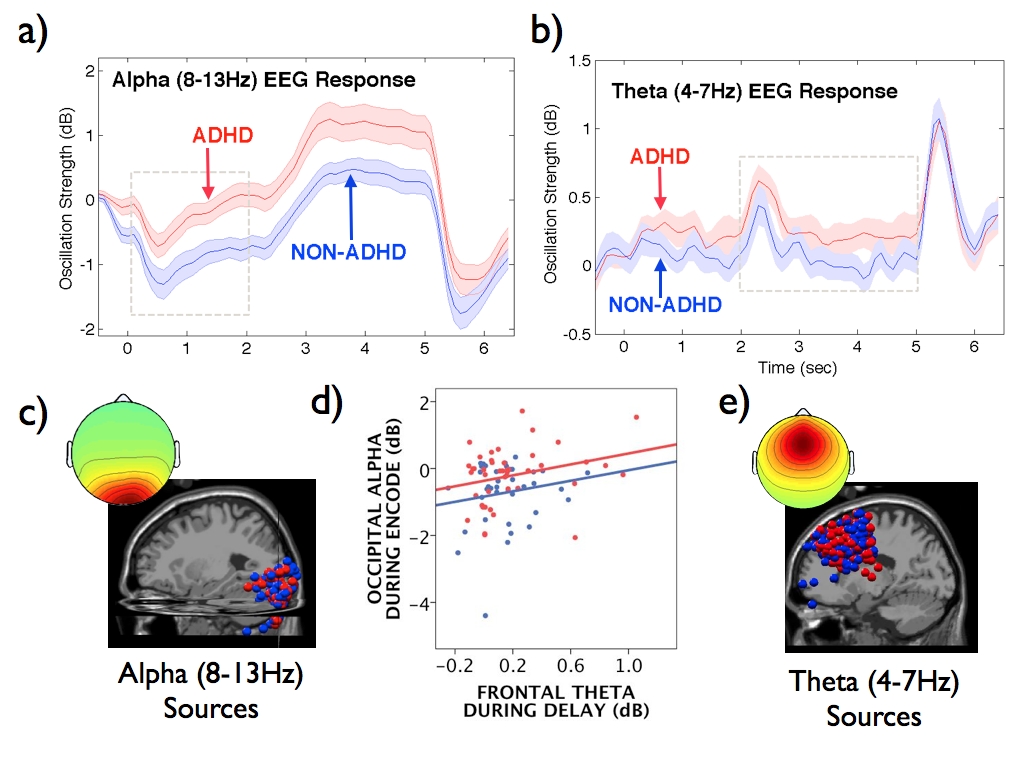|
59th Meeting of the American Academy of Child and Adolescent Psychiatry San Francisco, CA
Oct. 23-28, 2012
Agatha Lenartowicz, Ph.D.-1, Patricia Walshaw, Ph.D.-1; James T. McCracken, M.D.-1; James McGough, M.D.-1; Scott Makeig, Ph.D.-2; Sandra K. Loo, Ph.D.-1 ,
1-Semel Institute for Neuroscience and Human Behavior, University of California Los Angeles, 760 Westwood Plaza, Suite 17-369, Los Angeles, CA 90095;
2-Swartz Center for Computational Neuroscience, Institute for Neural Computation, University of California San Diego, La Jolla, CA
EEG correlates of spatial working memory in ADHD
Background: One of the most consistently reported cognitive deficits associated with ADHD is working memory (WM) (Castellanos & Tannock, 2002). However the precise mechanisms underlying this impairment beg clarification. Recent research (Friedman-Hill et al., 2010) suggests that this impairment may be partially attributed to attention-related deficits in recruiting WM, especially when task engagement is low. In the current study we tested this hypothesis.
Methods: The sample consists of 102 participants (52 children with ADHD, 50 typically developing children), aged 7-14 years old. A semi-structured diagnostic interview (KSADS-PL) was used to make diagnosis of ADHD and all co-morbid psychiatric disorders. Electroencephalographic (EEG) data using a 40-electrode cap were collected during a spatial Sternberg working memory task, during which participants are required to: (a) encode the position of 3-7 visually presented dots (2 sec), (b) maintain this spatial information for a 3-sec delay during which visual presentation is blank, and (c) retrieve the spatial information in order to determine if a visual probe (a single dot) is presented at one of the previously shown locations or at a new location. The EEG data collected during this were analyzed by combining independent component analysis combined and clustering (Onton et al., 2006), which allows for the identification of multivariate (across time, electrodes, and spectral frequency) EEG profiles that underlie task performance.

We examined two different types of component profiles that have been previously related to attention and WM processes. To evaluate the integrity of WM recruitment (an attention process) we identified components over (central) occipital scalp, and measured desynchronization (i.e., decrease) of alpha band (8-13Hz) oscillations during the encoding interval (Figs. 1a,c). To evaluate the integrity of WM, we identified components over fronto-central scalp, and measured synchronization (i.e., increase) of theta band (4-7Hz) oscillations during the maintenance interval (Figs. 1b,e). We then analyzed the mean power in each frequency profile using repeated-measures ANCOVA that included independent variables of diagnosis and task difficulty, while controlling for age. Additionally we tested whether occipital alpha and frontal theta are related by computing their correlation, partialing for age. Developmental effects were analyzed separately by dividing our participants into two groups according to median age (<10.5 and >10.5 years) and including an additional group factor (i.e., age) into the ANCOVA.
Results: Children with ADHD showed less desynchronization in the occipital alpha band oscillations (Figs. 1a,c) during WM encoding than children without ADHD (p<006). This effect was more pronounced when the task difficulty was low (group x diagnosis interaction p<.09), and predicted both fronto-central theta band power during WM maintenance (Fig. 1d) and task reaction time. In particular, less alpha desynchronization in the ADHD group during stimulus encoding was associated with both greater theta band power during maintenance (r=.34, p=.03) and slower reaction time (r=.32, p=.02). In addition, fronto-central theta band activity (Figs. 1b,e) was elevated in the ADHD group (p<.09) relative to controls. Because frontal-midline theta band power is typically elevated under increased task demands, this suggests that children with ADHD are exerting increased effort to compensate for poor WM encoding rather than deficient WM impairment per se. Moreover, the correlation between frontal-theta and occipital-alpha suggests that encoding process during encoding predict subsequent WM engagement during maintenance. Fronto-central theta band activity was also significantly correlated with ADHD symptoms (r=.19, p=.05).
Developmentally alpha was more negative in older children, but this age-related decrease was attenuated in the ADHD group. Additionally, fronto-central theta responses among children with ADHD showed a developmental effect that was qualitatively different than for typically developing children. An elevated theta response was present for both younger and older children the ADHD group and increased with age. This is in contrast to the control group in which theta decreased with age. These findings suggest that developmental differences between ADHD and control groups contribute to differences in EEG measures on the spatial working memory task.
Conclusions: We conclude that children with ADHD show an attentional-deficit during encoding. This deficit is consistent with a problem in WM recruitment that appears to influence WM integrity during subsequent maintenance. Interestingly, fronto-central theta, an index of WM, was elevated in children with ADHD across age and levels of task difficulty. This suggests that children with ADHD exert more effort to maintain items in WM than typically developing children. These findings imply that a more refined classification of WM deficits in ADHD may be warranted that includes WM interactions with other processing, such as encoding.
Bibliography:
Castellanos, F. X., & Tannock, R. (2002). Neuroscience of attention-deficit/hyperactivity disorder: The search for endophenotypes. Nature Reviews Neuroscience, 3(8), 617-628.
Friedman-Hill, S.R., Wagman, M.R., Gex, S.E., Pine, D.S., Leibenluft, E., Ungerleider, L.G. (2010). What does distractibility in ADHD reveal about mechanisms for top-down attentional control?Cognition, 2010. 115(1): p. 93-103.
Onton, J., Westerfield, M., Townsend, J., Makeig, S. (2006). Imaging human EEG dynamics using independent component analysis. Neuroscience and Biobehavioral Reviews, 30(6): p. 808-822.